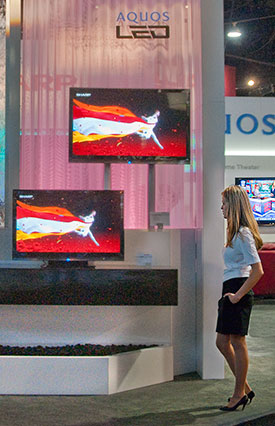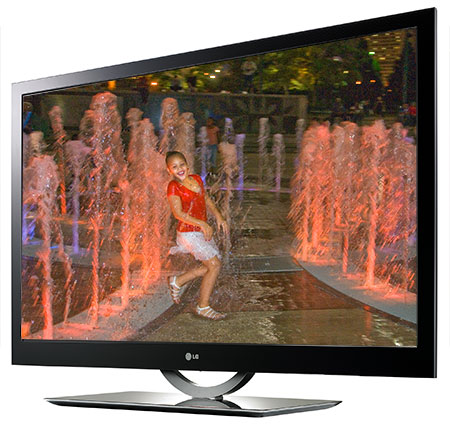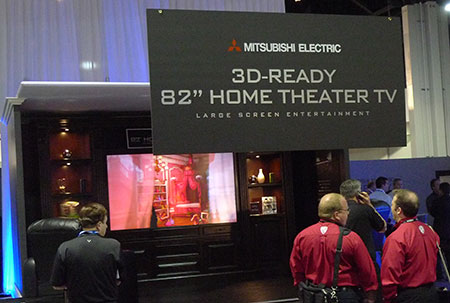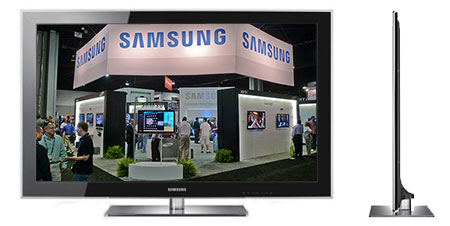
|
|
 |

|


 What in the HD World? What in the HD World?CEDIA 2009 Report
 Dick De Jong
Dick De JongSeptember 16, 2009 HDTV Solutions CEDIA, which stands for Custom Electronic Design & Installation Association, is an international trade association that consists of companies that specialize in designing and installing electronic systems for the home. They held their annual expo last week in Atlanta. As you can imagine in this economy, the mood was humbler than in past years. But the HDTV industry soldiered on, propelled by display technologies that are ever evolving. Let's look at a few trends that I saw as I walked around the Expo floor - one's old, one's quickly developing, and the other may take a year or two.  A TV Lover's Dollhouse at CEDIA 2009 LED TV
Before we begin talking about the cool guy on the block, let's clear up a little brouhaha brewing around the term LED TV. It's really a misnomer that throws some industry veterans into a near apoplectic fit. These TVs employ LEDs (light emitting diodes) for their backlight instead of the more traditional CCFL (cold cathode fluorescent lights).  Sharp's AQUOS LED TV The rub is that LED TVs still use LCD panels, in other words, basically they are LCD TVs. As one grizzled scribe commented, "If they call these new models LED TVs, they should call the old ones Fluorescent TVs." Be that as it may, almost every manufacturer was introducing a new TV with an LED backlight. And the LED train is just picking up steam. DisplaySearch recently reported that, "LCD TV panel makers are planning to ship 4.3 million panels with LED backlights in 2009, 68% side-light type and 32% direct." As you can see, designers of this type of display are placing the LEDs in two different locations. Right now, the more common method is to position the LEDs around the outer edge of the LCD. These LED edge-lit TVs can be super slim, often less than an inch and a half wide. For example, in October, Sony is rolling out their XBR10 LED edge-lit TV. Adding to the WOW factor, it is wireless. Not just Internet Wi-Fi wireless, but also a receiver is embedded in the TV that can accept 1080p signals wirelessly transmitted from a separate media box that can be up to thirty feet away. Think about it. You can run all your cables from your set top box or the Blu-ray player into this media box. Which means no video and audio cables dangling off your TV. Just plug the XBR10 into a wall outlet.  Aerial View of Sony's XBR10 But as much as I like razor thin TVs, what really excites me about LED technology is the picture quality possible from a technique called local dimming. Currently, local dimming is only possible when the LEDs are placed directly behind the LCD panel and not on the edge. (As a point of clarification, not all direct-lit LED TVs utilize local dimming.) Picture an array of little LEDs lighting up the LCD. Now, with local dimming, when portions of the image on the screen are dark, the LEDs behind that part of the image are dimmed accordingly. This process increases contrast and produces deeper blacks.  Toshiba's LED TV Booth Toshiba set up a side-by-side comparison of their new local dimming LED model, the 46SV670U, next to a CCFL LCD and the differences in black levels were dramatic. I'm just finishing a review of this Toshiba and the results in our testing facility are similar. I saw my first demonstration of local dimming almost two years ago and models have slowly dribbled out from a few manufacturers. In the next year, I think that you will see a lot more choices from almost all TV makers. For example, in a private suite away from the showroom floor, VIZIO was previewing their first local dimming model, (they call it Smart Dimming), the 47" SV472XVT, which should be available in October. Not to be outdone by the competition, LG was trumpeting their 55LHX. This 55" 240Hz full-array LED backlit TV includes local dimming. I'm not a big believer in the importance of dynamic contrast numbers but I thought I should share LG's claim of 5,000,000:1. The 55LHX is also THX certified and it's wireless.  The LG LHX55 You can start to see why I believe that the future is bright for local dimming LEDs. I will periodically update their progress. 3D-Ready TV
In the trend-to-be category, the industry is promoting the 3D-Ready TV. Or I should say 3D-Ready TVs (plural) because as I strolled around the Expo, I saw at least three different methods of creating and viewing 3D content. As a reminder, when you feed regular HD signals into a 3D-Ready TV, it looks and acts just like a normal HDTV. But when it is playing back 3D content, the TV displays a left and right eye image which is viewed properly through a set of glasses. The process fools our brain into thinking it's seeing in three dimensions. There is more than one method to skin this 3D cat. For example, JVC was touting their 3D model, the GD-463D10, that uses an Xpol polarizing filter method. Panasonic showcased their Full HD 3D solution in an 18 wheeler parked on the convention floor. They were thrilling the attendees with a 103" plasma that employed the frame sequential method that requires LCD shutter glasses. I'll admit that I'm not over the moon about the 3D experience. Who needs pointy objects flying out of the screen at you? And oh those glasses. But Panasonic showed a short clip of the drummers at the opening ceremony of the Beijing Olympics and the sharpness and dimensionality of the image was startling.  Panasonic's 3D Traveling Roadshow Sony is also committing to a 3D TV solution within a year. Of course, over at Mitsubishi, they were wondering what all the hubbub was about since they have been showing a 3D capable line of TVs for over two years. For 3D TVs to catch fire in the marketplace, three elements need to coalesce: display, playback and content. I've seen a number of viable 3D display technologies. For the consumers' sake, I hope the industry can settle on one. With movie studios churning out more and more 3D movies, the content pipeline is beginning to reach critical mass. Though in the near future, I don't expect to see any wide ranging 3D application available over cable or broadcast TV. The real bottleneck in the 3D TV equation is in playback. Simply, we need a 3D Blu-ray player. Until one is commercially available, the whole 3D on TV movement is stalled. I assume a lot of folks are working on a 3D Blu-ray player. I just haven't seen any official announcements. Of course, even with a 3D Blu-ray player, the 3D bandwagon still can be fettered if TV makers and movie studios charge too high a premium for their 3D products.  3D is Old Hat to Mitsubishi Plasmas
Some of you may be thinking, "I thought plasmas were dead, how can they be a trend?" I'll admit that I'm still a big fan of plasmas so I look for any life I can find in this technology. LEDs and 3Ds may be grabbing all the headlines, but if you dig, plasmas are still alive and kicking - and progressing. Remember that plasmas were always venerated for their picture quality advantage over LCDs. Local dimming LED TVs are just beginning to close the gap in contrast and black levels. On the flip side, plasmas were traditionally power guzzlers, but fabricators of plasmas are constantly squeezing more efficiency out of the panels.  Plasmas Can Be Thin Too, The 1.2" Samsung PN50B850 If you had any doubt about the majesty of plasmas, the Panasonic Professional Display Company set up their new 85-inch professional plasma, the TH-85PF12U, against some of the better LCD models. The Panasonic team was rightfully proud of their big boy. I asked a number of representatives from plasma TV manufacturers and they all said that they were committed to continuing their plasma lines. Though one did comment that the plants that make plasma TVs are probably the easiest ones to retool to make OLED TVs. And what is the future of the whiz bang OLED TV? The week before CEDIA at the IFA convention in Berlin, LG revealed a 15" OLED model. They weren't displaying it at CEDIA, though I assume it will reappear at CES in January. Unless OLED makers have a manufacturing breakthrough, we probably will not see large quantities of OLED TVs over 32" for at least a year or two or maybe three. Beyond the Trends
I should mention that 120Hz and 240Hz LCDs were everywhere. Since DisplaySearch reports that they are "expected to account for half of 40"+ LCD TV panels in 2009, I no longer consider them a trend but more of a mainstream product. I did not see any 480Hz prototypes at CEDIA though I know they are out there. Also, I have already reviewed a number of TVs that provide access to Internet content. It's a no-brainer to predict that 2010 will be the year of Internet connected TVs with widgets popping up on many of the new models. If you're not ready to buy a new TV but still want to march in the Internet connected parade, most new Blu-ray players will include the feature. And Sherwood has even introduced their R-904N NetBoxx Internet A/V receiver, which can connect to web streaming partners like YouTube, Netflix and Hulu. And the beat goes on. Stay tuned.  Riffing Outside the Atlanta Chamber of Commerce |
Bookmark:
![]() del.icio.us
del.icio.us
![]() Reddit
Reddit
![]() Google
Google
| Send this Page | Print this Page | Report Errors |

